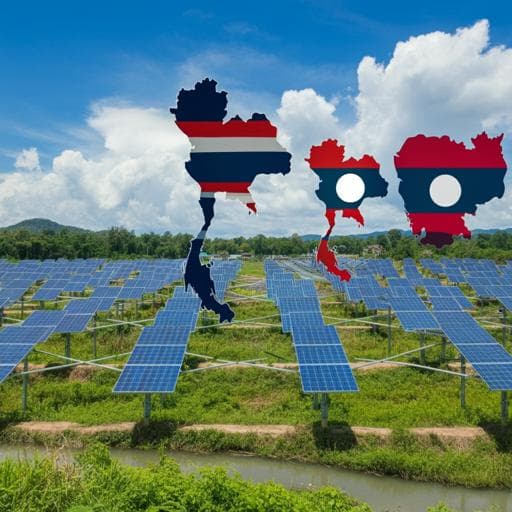
Environmental Studies and Forestry
Solar energy and regional coordination as a feasible alternative to large hydropower in Southeast Asia
K. Siala, A. K. Chowdhury, et al.
Discover how integrating solar PV and regional coordination can revolutionize energy consumption in Southeast Asia! This groundbreaking research by Kais Siala, Afm Kamal Chowdhury, Thanh Duc Dang, and Stefano Galelli unveils smarter alternatives to large hydropower projects, promoting both sustainability and ecosystem health.
~3 min • Beginner • English
Introduction
Southeast Asia’s power systems have relied heavily on hydropower and fossil fuels to support rapid economic growth and expand electricity access. In the Mekong River Basin—one of the world’s biodiversity hotspots and home to the largest freshwater fishery—hydropower development has accelerated, with 41.6 GW commissioned by 2020 and a further ~22 GW planned. Large dams alter hydrology, fragment river networks, impede fish migration, and reduce sediment and nutrient transport, with profound ecological and social impacts. Simultaneously, regional interconnections and rapidly improving costs of solar PV offer alternative pathways to meet rising electricity demand while reducing emissions and environmental harm. However, strategic dam planning and deployment of decentralized renewables are typically addressed separately. The research question posed is whether integrated power system planning that jointly considers dam portfolios, solar PV, and regional grid coordination can feasibly and economically meet future demand and CO2 targets for Thailand, Laos, and Cambodia while mitigating river fragmentation and flow regulation impacts.
Literature Review
The study builds on two strands of literature. First, strategic dam planning frameworks use multi-objective optimization to balance hydropower benefits with environmental objectives, such as maintaining fish biomass and biodiversity, reducing sediment trapping, and limiting reservoir GHG emissions. These works identify more sustainable dam portfolios but generally do not embed dams within broader power system operations. Second, energy systems research for ASEAN has examined cross-border grid flexibility, renewable integration potential, and cost-optimal decarbonization pathways, highlighting the growing competitiveness of solar PV and the role of regional interconnections. Prior studies in other regions (e.g., Africa, Myanmar, South Africa) suggest decentralized renewables and transmission siting can reduce reliance on large hydropower and fossil fuels. This paper integrates these strands by coupling high-resolution hydrological modeling with a power system capacity expansion model and by assessing ecological impacts using river fragmentation and regulation indices.
Methodology
The authors couple hydrological-water management modeling with a linear capacity expansion and dispatch model, augmented by river connectivity/regulation metrics, to assess dam portfolios and energy system pathways for Thailand, Laos, and Cambodia (LTC) through 2037.
- Hydrology and reservoir operations: They use VIC (Variable Infiltration Capacity) for runoff generation and VIC-Res to explicitly simulate storage-release dynamics and daily hydropower production at dam level across the Mekong and Chao Phraya basins at 1/16° resolution. Two domains are built: Mekong (~635,000 km²) from the Tibetan Plateau to Kratie, simulating 108 dams operational in 2016; and Chao Phraya (~110,000 km²) including Bhumibol and Sirikit. Inputs include GTOPO30 DEM, land use (GLCC), soils (HWSD), and meteorological forcing (Global Meteorological Forcing Dataset). Reservoir bathymetry is estimated via Liebe’s method; max surface extents from Landsat; design specs from MRC and EGAT. Bespoke rule curves draw down in dry season and refill during monsoon, tailored per reservoir. Calibration (1996–2005) and validation (2007–2016) are conducted using observed discharges and comparisons of simulated mean annual hydropower against design production.
- Hydropower profiles for future/planned dams: Due to computational limits in the power model, a single representative hydrological year (2015) is used to derive daily hydropower profiles, then uniformly distributed across hours. Dams built 2017–2019 are added and re-simulated. For remaining planned/under-construction dams (2020–2037) lacking detailed specs, a proximity-based analog approach assigns profiles from the most similar existing dam.
- Capacity expansion model: The open-source urbs framework (Python/Pyomo, solved with Gurobi) co-optimizes generation, transmission, and storage expansion and hourly dispatch for years 2016, 2020, 2025, 2030, 2035, and 2037 across 120 regions (provinces of Cambodia, Laos, and Thailand). Objective is minimizing total system cost (annualized CAPEX, fixed/variable O&M, fuel). Inputs: hourly demand (derived from provincial monthly peaks and scaled by projected growth: Thailand 4.3%/yr, Cambodia 8.8%/yr, Laos 9.5%/yr), hourly renewable profiles, existing/planned infrastructure, emissions targets (reduce emissions intensity from ~0.536 to 0.308 tCO2/MWh), techno-economic parameters. Spatial detail preserves transmission bottlenecks; electricity trade among LTC is fully coordinated; trade with China, Malaysia, Myanmar, Vietnam held at current levels. Solar and wind siting uses resource classes with capacity limits (max installable: solar PV 106.6 GW; onshore wind 21.2 GW). Hydropower plants are modeled individually at dam level. No expansion allowed in 2016; new capacities roll forward between modeled years.
- Dam development portfolios: Four cases are assessed (plus 2016 baseline): Reference (build all planned dams), Stop-Main (build only tributary dams; stop main-stem dams), Stop-Planned (halt all not-yet-started planned dams from 2020), and Stop-All (halt all planned and under-construction dams from 2020). Portfolio characteristics are summarized from databases (MRC, EGAT, WLE, etc.).
- Ecosystem impact metrics: River Fragmentation Index (RFI) quantifies loss of longitudinal connectivity (0–100%), based on volumes of network fragments separated by dams. River Regulation Index (RRI) aggregates Degree of Regulation (DOR) across reaches, weighting by reach volume, to quantify alteration of flow regimes (RRI can exceed 100% with carryover storage). DOR for each reach is sum of upstream storage capacities over annual discharge. Network geometry derived from VIC-Res flow directions (1/16°; ~100,000 km of rivers; 14,214 reaches). For all portfolios and time slices, LTC dam selections from urbs-VIC-Res are used; all dams in China (Upper Mekong) are assumed to be constructed as planned to reflect lack of cross-border coordination.
Key Findings
- Feasible low-hydro pathways: Thailand, Laos, and Cambodia can meet projected electricity demand and emissions intensity targets with substantially fewer dams than currently planned, from halting all new Lower Mekong dams to building about 82% of planned capacity.
- Near-term decarbonization (2020): Gas replaces some coal in Thailand due to stringent emissions intensity constraints and still-high PV costs, reducing imports from Laos.
- Post-2025 shift to renewables: From 2025 onward, coal generation remains similar to 2016 levels, gas share decreases, and large-scale renewables are added, dominated by solar PV. Wind potential is limited.
- Solar PV expansion: Solar reaches 52 GW by 2025 and 68.2 GW by 2037 across LTC. Thailand adds 49.8 GW (≈42% of its 2037 total capacity). Solar provides 89.2 TWh in 2037, supplying 49.8% of carbon-free generation.
- Hydropower capacity: Increases from 9.3 GW (2016) to 22.8 GW (2037), mostly in Laos (+12 GW) and Cambodia (+1.8 GW), plus 0.7 GW in Myanmar for Thailand. Reference corresponds to executing ~82% of planned regional hydropower (17.6 GW planned total).
- Transmission expansion: About 25 GW of bidirectional transmission capacity is added to connect new hydro hubs (southern/northern Laos, northeastern Cambodia, eastern Myanmar) and distributed solar to demand centers (notably Bangkok), implying high regional coordination.
- Carbon-free generation share: Rises from 16.7% (2016) to 42.9% (2037). By 2037, hydropower constitutes less than half of carbon-free generation; solar dominates the remainder.
- Portfolio substitutions and costs: Reduced-hydro portfolios are technically feasible; lost hydropower is offset mainly by solar PV and gas. Higher hydro share allows more coal within the CO2 cap (coal cheaper than gas but higher intensity), whereas lower-hydro cases substitute with more gas. Cumulative system costs to 2037 rise only marginally versus Reference; Stop-All is +2.4% (~US$10 billion) over 2016–2037.
- River ecosystem impacts: RFI jumps from 17.4% (2016) to 66.6% (2020) due to recent Lower Mekong main-stem and major tributary dams (e.g., Xayaburi, Lower Sesan 2). Future RFI ranges from 66.6% (Stop-All) to 80.5% (Reference). Portfolios have limited influence on RRI because Lower Mekong planned dams generally have low storage-to-inflow ratios; projected RRI increase is driven mainly by large-storage dams in the Upper Mekong (China). DOR analyses show few large Chinese reservoirs can elevate regulation along most of the main stem (>25%).
Discussion
The integrated planning results show that solar PV combined with enhanced regional coordination can substantially reduce the need for additional hydropower while meeting demand growth and emissions intensity targets. The marginal total cost increases (≤2.4%) for reduced-hydro portfolios are commensurate with potential avoided damages (e.g., to inland fisheries) and broader socio-environmental externalities of large dams (GHG emissions from reservoirs, thermal pollution, community displacement). Solar’s scalability and geographic ubiquity across provinces allow localized generation that complements seasonal hydropower, with flexibility needs covered by gas plants in the short-to-mid term without immediate utility-scale storage. However, under current Thai decarbonization targets, retaining more hydropower can paradoxically enable greater coal usage within the emissions cap; more stringent future targets would likely require both substantial solar and hydropower to displace coal fully. Ecologically, while careful LTC system expansion can curb further fragmentation, alterations to natural flow regimes are strongly influenced by Upper Mekong dam development, underscoring the need for transboundary coordination. The study demonstrates the value of coupling dam portfolio design with power system capacity expansion to ensure environmental portfolios remain technically and economically viable within real grid and policy constraints.
Conclusion
An integrated multi-model framework reveals that Thailand, Laos, and Cambodia can achieve projected electricity demand and emissions intensity goals with fewer hydropower dams than currently planned, largely by scaling solar PV and strengthening cross-border coordination and transmission. Even the most restrictive portfolio (Stop-All) increases cumulative system costs by only ~2.4% (~US$10 billion) to 2037 while significantly limiting additional river fragmentation. Nevertheless, future flow regulation is driven primarily by Upper Mekong large reservoirs, highlighting the importance of basin-wide coordination. The work contributes a methodology that couples high-resolution hydrology and reservoir operation modeling with spatially detailed capacity expansion and ecological indices, enabling direct evaluation of dam roles within power systems and associated ecology-energy trade-offs. Future research should: (i) jointly plan dams and power systems dynamically, (ii) complement basin-scale screening with local-scale impact assessments (e.g., sediment, fish passage), (iii) assess reliability implications under extreme demand variability, and (iv) explore scenarios with more ambitious decarbonization and evolving storage technologies.
Limitations
- Computational constraints necessitated using a single representative hydrological year (2015) for hydropower profiles; sensitivity tests indicate marginal impacts, but full interannual variability is not captured in the expansion optimization.
- Full operational coordination is assumed among Thailand, Laos, and Cambodia, while power trade with other neighboring countries is held at current levels; actual geopolitical and market constraints may differ.
- Hydropower profiles for many planned dams were assigned via proximity-based analogs due to missing design details, introducing uncertainty.
- Emissions intensity targets and policy assumptions are based primarily on Thailand’s PDP; different national policies or future tightening of targets would alter optimal pathways.
- Storage technologies are not expanded as a central balancing resource; short-to-mid term flexibility relies on gas ramping, and large-scale storage deployment pathways are not explored.
- River impact indices assume full passability loss at dams and that all Upper Mekong (China) dams are built as planned; cross-border coordination changes could modify RFI/RRI outcomes.
- The basin-scale screening necessarily omits some local processes (e.g., detailed sediment dynamics, fish passage, thermal impacts) and does not test system reliability under extreme events; local-scale studies are recommended.
- Renewable resource potentials are capped (solar 106.6 GW, wind 21.2 GW) based on conservative estimates; alternative siting/land-use assumptions could change results.
- Cost estimates rely on assumed techno-economic trajectories and may be affected by future cost overruns or commodity price fluctuations.
Related Publications
Explore these studies to deepen your understanding of the subject.







